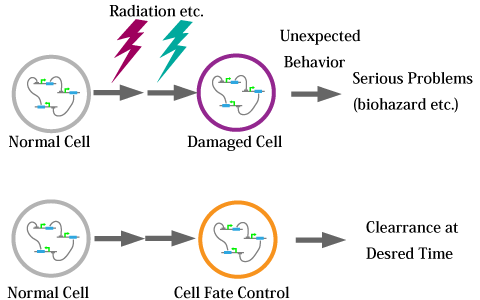Team:Kyoto/GSDD/Introduction
From 2009.igem.org
(→Safety issue) |
|||
| Line 35: | Line 35: | ||
==Safety issue== | ==Safety issue== | ||
Safety Issue | Safety Issue | ||
| - | Our ultimate goal is to make a device which enables us to control exact cell’s life time (or death time) depending on the number of cell division times. If engineered cells have mutation and increase too much, it may cause the unexpected behavior (biohazard) against natural living systems. Our device certainly contributes to prevention of biohazard. | + | Our ultimate goal is to make a device which enables us to control exact cell’s life time (or death time) depending on the number of cell division times. If engineered cells have mutation and increase too much, it may cause the unexpected behavior (biohazard) against natural living systems. Our device certainly contributes to prevention of biohazard.What we did in laboratory was completely free of anything harmful for environment and ourselves. |
| + | We disposed of wastes such as biohazardous waste properly, and we were careful with toxic material. | ||
| + | Biohazard was not caused during our experiment. | ||
</div><!-- /#rightcontents --> | </div><!-- /#rightcontents --> | ||
Revision as of 23:26, 21 October 2009
Motivation
In synthetic biology field, biologists and bioengineers design and construct a variety of gene circuits to solve their facing problems such as medical, environmental, food, and energy problems. However, it is difficult to control the lifespan of these engineered cells that contain synthetic circuits in many cases: the cells tend to repeat cell division and increase their number in the given environment. Moreover, if point mutations or deletions were introduced into such engineered cells, it may cause serious problems to the natural environment, because they may cause the unexpected behavior (biohazard) against natural living systems. This is the big issue in this field. However, it is difficult to invent an effective approach to control the cell fate of the engineered bacteria.
For instance, several synthetic biologists aimed to regulate cell population by introducing a negative feedback loops or the other circuits in cells (REF). As a result, they could control the cell populations in some cases. However, these regulations can not precisely control the temporal gene expression depending on cell division. Thus, we aimed to design and construct a system to control the temporal gene expression depending on cell division without using the other factors (e.g., small molecules such as Tetracycline or complicated genetic circuits).
Safety issue
Safety Issue Our ultimate goal is to make a device which enables us to control exact cell’s life time (or death time) depending on the number of cell division times. If engineered cells have mutation and increase too much, it may cause the unexpected behavior (biohazard) against natural living systems. Our device certainly contributes to prevention of biohazard.What we did in laboratory was completely free of anything harmful for environment and ourselves. We disposed of wastes such as biohazardous waste properly, and we were careful with toxic material. Biohazard was not caused during our experiment.
 "
"
